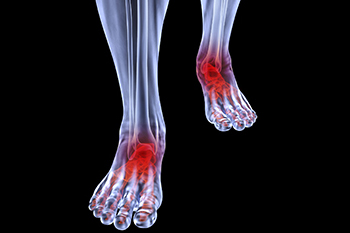
Conditions affecting the feet due to complications with arthritis can take many forms, including osteoarthritis, rheumatoid arthritis, gout, psoriatic arthritis, and ankylosing spondylitis. Osteoarthritis can affect any joint in the foot. Sometimes it is the big toe joint and sometimes it is in the midfoot or ankle region. Unlike osteoarthritis, rheumatoid arthritis typically affects both feet and deals with the same joints on each foot. Gout, which normally affects the big toe, is comprised of needle-like crystals that trigger inflammation in the joints. Psoriatic arthritis causes sausage-like swelling in the toes. Lastly, ankylosing spondylitis can lead to plantar fasciitis and pain at the Achilles tendon.
Many factors play a role in the cause for arthritic feet, including obesity, the aging process, as well as family history or genetic connections to arthritis.To help help prevent arthritic issues with your feet the best thing is prevention. Decrease impact to your feet while continuing exercise and cardiovascular exercise. Wearing arch supports/orthotics is the the most effective thing you can do to prevent strain on the joints of the midfoot and rearfoot. Making sure your shoes are not too soft and flexible is also a way to prevent breakdown of the joints in the feet.
If you’re experiencing any discomfort or pain due to one of the above forms of arthritis, consider over-the-counter pain medication and investing in supportive footwear. The most effective over-the-counter orthotic is The Foot Chair. This is the only customizable orthotic availabe and the most supportive while being guaranteed.
It’s important to note that almost all shoes, regardless of price, do not have any arch support. They tell you they do and instead they have a pad or a liner, but there is no arch support. do research and see whether inserts may be beneficial for you. General foot care, like pampering your feet and keeping them well maintained, is also recommended. Lastly, you should seek professional advice and learn about potential surgery options, if necessary.
For an official diagnosis and information on treatment options, consult with Dr. DiNucci.
